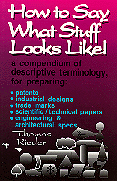

![]()

|
How to Say What Stuff Looks Like!
Thomas Rieder.
Grades 10 and Up / Ages 14 to Adult.
*** /4
|
excerpt:
. . . Here is some trivia that might come in handy one day, for example when at a cocktail party you are desperately seeking some clever conversational gambit to intrigue and entertain the Potential Significant Other (PSO) who has been smiling at you all evening: all positive numbers can be divided into three kinds: Abundant Numbers, Deficient Numbers and Perfect Numbers. . . .
 THEN AGAIN, it may never come in handy. But that captures the tone of this light-hearted, almost eccentric reference work on descriptive terminology. Author Thomas Rieder, a long-time patent agent, spent many years collecting accurate definitions of shapes that he regularly encountered (and had to describe). After he realized people other than patent agents might find his work useful, that list became the origin of How to Say What Stuff Looks Like!
THEN AGAIN, it may never come in handy. But that captures the tone of this light-hearted, almost eccentric reference work on descriptive terminology. Author Thomas Rieder, a long-time patent agent, spent many years collecting accurate definitions of shapes that he regularly encountered (and had to describe). After he realized people other than patent agents might find his work useful, that list became the origin of How to Say What Stuff Looks Like!
Roget's Thesaurus and other reference works had similar humble beginnings. In recent years, visual dictionaries have been appearing of greater and lesser usefulness -- the dry Canadian Stoddart Visual Dictionary (1986), for example, or the more useful and colloquial What's What (Random House, 1981). Neither of those books has Rieder's concentration on geometrical description, however -- in fact, they hardly cover geometrical forms at all.
Geometry is the core of technical description, however, and Rieder's book provides not only page after page of simple but clear illustrations, enabling you to flip through the appropriate section to find out that a square with a smaller square taken out of one corner is properly called a gnomon; use the index to find a picture of a term whose precise definition you can't remember; or just be enlightened by his sections of general explanation. For example:
What may not be generally known is that many of the ``uniform" shapes to be dealt with in this chapter [``Two-dimensional Curvilinear Figures"] are what we call conic sections, meaning that they have shapes that can be produced by cutting a standard cone along certain planes. The drawing at the top of page 22 shows how the circle, the ellipse, the parabola and the hyperbola can be generated by passing a flat plane through a circular cone at various angles. . . .

Surprisingly clear and succinct. And throughout Rieder provides touches of wit in both the definitions and the drawings (for example, in the illustration defining crater-like, a small stick-figure flees in terror from what appears to be a volcano -- certainly a crater-like shape).
The audience for the book is probably narrower than the casual title would suggest, however. Most of the text is limited to defining geometric terms (loxodrome, for example) that will only rarely be of use to a non-specialist, particularly of student age. On the other hand, senior science and geometry students will find themselves at a loss for ways to describe shapes from time to time, and the definitions and illustrations here will help them quickly.
Rieder's book is as friendly and accessible as the subject allows, and it has been bound to lie flat without breaking the spine. There are a few annoyances, however -- for instance, the text uses typewriter-style quotation marks, rather than typographical ones. The medium in which CM is published has the same limitation, but in physically printed work it's the first sign of lazy (or amateur) design.
And since many of the definitions are unavoidably cross-referential, it's frustrating that all defined terms aren't marked off by boldface when they appear, and made easier to find. For example, the definition of a triangle uses the term vertex, but if you don't know the word, you must read the next page before finding that Rieder defines it for you. Similarly with parralelogram, the definition of which appears after Rieder begins using it to define other four-sided shapes. More work needs to go into the next edition.
In all, a slim and entertaining work on a subject of limited usefulness.
Recommended with reservations.
T.S. Causabon is a freelance writer in Winnipeg formerly unaware of the difference between a spiral and a helix.
To comment on this title or this review, send mail to cmeditor@mts.net.
![]()
Copyright © 1996 the Manitoba Library Association.
Reproduction for personal use is permitted only if this copyright notice
is maintained. Any other reproduction is prohibited without permission.
Published by
The Manitoba Library Association
ISSN 1201-9364
![]()